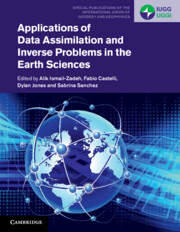Book contents
- Applications of Data Assimilation and Inverse Problems in the Earth Sciences
- Series page
- Applications of Data Assimilation and Inverse Problems in the Earth Sciences
- Copyright page
- Contents
- Contributors
- Preface
- Acknowledgements
- Part I Introduction
- Part II ‘Fluid’ Earth Applications: From the Surface to the Space
- 5 Data Assimilation of Seasonal Snow
- 6 Data Assimilation in Glaciology
- 7 Data Assimilation in Hydrological Sciences
- 8 Data Assimilation and Inverse Modelling of Atmospheric Trace Constituents
- 9 Data Assimilation of Volcanic Clouds: Recent Advances and Implications on Operational Forecasts
- 10 Data Assimilation in the Near-Earth Electron Radiation Environment
- Part III ‘Solid’ Earth Applications: From the Surface to the Core
- Index
- References
6 - Data Assimilation in Glaciology
from Part II - ‘Fluid’ Earth Applications: From the Surface to the Space
Published online by Cambridge University Press: 20 June 2023
- Applications of Data Assimilation and Inverse Problems in the Earth Sciences
- Series page
- Applications of Data Assimilation and Inverse Problems in the Earth Sciences
- Copyright page
- Contents
- Contributors
- Preface
- Acknowledgements
- Part I Introduction
- Part II ‘Fluid’ Earth Applications: From the Surface to the Space
- 5 Data Assimilation of Seasonal Snow
- 6 Data Assimilation in Glaciology
- 7 Data Assimilation in Hydrological Sciences
- 8 Data Assimilation and Inverse Modelling of Atmospheric Trace Constituents
- 9 Data Assimilation of Volcanic Clouds: Recent Advances and Implications on Operational Forecasts
- 10 Data Assimilation in the Near-Earth Electron Radiation Environment
- Part III ‘Solid’ Earth Applications: From the Surface to the Core
- Index
- References
Summary
Abstract: Data assimilation has always been a particularly active area of research in glaciology. While many properties at the surface of glaciers and ice sheets can be directly measured from remote sensing or in situ observations (surface velocity, surface elevation, thinning rates, etc.), many important characteristics, such as englacial and basal properties, as well as past climate conditions, remain difficult or impossible to observe. Data assimilation has been used for decades in glaciology in order to infer unknown properties and boundary conditions that have important impact on numerical models and their projections. The basic idea is to use observed properties, in conjunction with ice flow models, to infer these poorly known ice properties or boundary conditions. There is, however, a great deal of variability among approaches. Constraining data can be of a snapshot in time, or can represent evolution over time. The complexity of the flow model can vary, from simple descriptions of lubrication flow or mass continuity to complex, continent-wide Stokes flow models encompassing multiple flow regimes. Methods can be deterministic, where only a best fit is sought, or probabilistic in nature. We present in this chapter some of the most common applications of data assimilation in glaciology, and some of the new directions that are currently being developed.
Keywords
Information
- Type
- Chapter
- Information
- Publisher: Cambridge University PressPrint publication year: 2023
References
Accessibility standard: Unknown
Why this information is here
This section outlines the accessibility features of this content - including support for screen readers, full keyboard navigation and high-contrast display options. This may not be relevant for you.Accessibility Information
- 2
- Cited by
